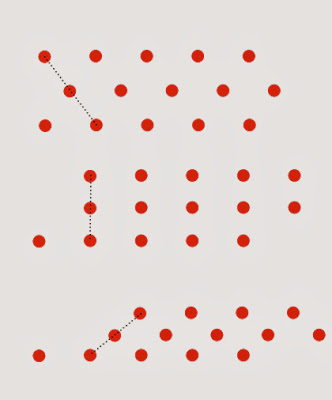Coordinated tessellations occur in two practical problems that arise in relation to telescopic heliostats: first, the problem of simultaneously packing the primary mirrors (as seen from the sun) and the secondary mirrors (as seen from the beam-down optics;) and second, the problem of simultaneously packing the primary and secondary lenses in the divergence reshapers that are a necessary part of the beam-down optics.
Definition: Two tessellations of the plane are centroid-coordinated when they are overlain such that each tile has its centroid coincident with that of a tile in the other tessellation.
Non-trivial centroid coordination (when the two tessellations are not identical) is possible because, when acting on an array of unlabeled points (like the tile centroids of a tessellation,) inequivalent affine transformations may act identically. In other words, if we apply two inequivalent affine transformations to a tessellation we will generate two different tessellations as a result, but applying the same two transformations to an array of unlabeled points (e.g., the tile centroids) may give identical results.
For example, consider a set of tile centroids that are arrayed in a brick-layer's "stretcher bond" pattern as in the top arrangement in the figure above. Shearing this array of points takes them out of proper stretcher bond order (middle arrangement)—but shearing them some more can bring them back into a new stretcher bond order (bottom arrangement.) The height of the bricks is now too short, but that is easily corrected by composition with another affine transformation that is a magnification in one dimension only. This newly contrived composite transformation and the identity transformation now act identically on the array of tile centroids, but differently on the tessellation. The two tessellations generated by the transforms are centroid-coordinated.
The shearing-plus-magnification transform we need is just a shearing in which only x-coordinates are altered. The magic angles that work for this shearing, are ones for which dots translate in the x-dimension by an integer multiple, n, of the inter-dot distance, d.
For the stretcher bond pattern with shearing angle θ:
(d/ √3) * tanθ = n * d,
tanθ = n √3.
For the Cartesian grid pattern
d * tanθ = n * d,
tanθ = n.
Rectangle tesellations
When two rectangle tessellations, a and b, are centroid coordinated, their heights, ha and hb, and widths, wa and wb, are related by two integers, m and n. Taking the rectangles of type a to be the taller, and those of type b the wider:
ha = m hb
wb = n wa.
But the rectangle areas are equal:
ha * wa = hb * wb
so,
m hb * wa = hb * n wa
m = n.
This is just the commonsense notion that, if two rectangles have the same area, and one is a factor f times taller, it must also be a factor of f times narrower. For rectangles in centroid-coordinated tessellations the constraint is added that f must be an integer.
Since the affine transformation of a polygon’s centroid is the centroid of the affine transformation of the polygon, once we have found a pair of centroid-coordinated tessellations, applying an affine transformation to both will generate a new pair of centroid-coordinated tessellations. For centroid-coordinated rectangle tessellations, their integer characteristic m is not altered by affine transformation, but we can vary the size and aspect ratio one species of rectangle just as we please by choosing different values of linear magnification in each dimension.
Since the affine transformation of a polygon’s centroid is the centroid of the affine transformation of the polygon, once we have found a pair of centroid-coordinated tessellations, applying an affine transformation to both will generate a new pair of centroid-coordinated tessellations. For centroid-coordinated rectangle tessellations, their integer characteristic m is not altered by affine transformation, but we can vary the size and aspect ratio one species of rectangle just as we please by choosing different values of linear magnification in each dimension.
For example, we can choose an affine transformation that turns one species of rectangles into squares. Therefore, every pair of centroid-coordinated rectangle tessellations is related by an affine transformation to another pair of centroid-coordinated rectangle tessellations having the same value of m, but where one species of rectangles are squares and the aspect ratio of the other species of rectangles is m squared.
For example, in designing a divergence reshaper having optical inputs and outputs that are delimited by solid angles of rectangular shape, if the output solid angle must be square in shape, the input solid angle must be a rectangle of aspect ratio m2, where m is an integer.
For example, in designing a divergence reshaper having optical inputs and outputs that are delimited by solid angles of rectangular shape, if the output solid angle must be square in shape, the input solid angle must be a rectangle of aspect ratio m2, where m is an integer.



No comments:
Post a Comment